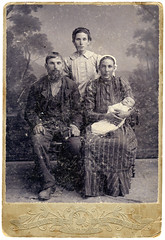 Take a close look at the oldest family photos that you have. Or, walk into an antique store and browse through some really old photos. Why aren’t these people smiling? There are some really good reasons why they looked so serious in photos.
Take a close look at the oldest family photos that you have. Or, walk into an antique store and browse through some really old photos. Why aren’t these people smiling? There are some really good reasons why they looked so serious in photos.
Today, you can take your family to JC Penney, or Sears, or a number of other places, and have a family portrait taken. The photographer is going to encourage your family members to smile. You will probably be instructed to “Say cheese!” It is difficult to say the word “cheese” without smiling.
It takes a second (or maybe less) for your family portrait to be taken. The photographer might use a computer to show you how the photo came out. If you don’t like it, another can be taken right away. It is no longer unusual to come home from this experience carrying a CD that has digital copies of the photos that were taken that day.
When you look at the old family photos that were taken of your ancestors, you will notice many things that are different than the photos your family took for Christmas. The old photos are not in color. The people in the photos are not smiling. Instead, they look very serious and formal. Why?
The answer has a lot to do with the technology of the time. Your ancestors were not able to walk into a photo studio, have a photo quickly taken, and leave a few minutes later with the photo in hand.
It wasn’t as easy to take a family photo back in the days of your ancestors. In 1839, the daguerreotype required fifteen minutes for a photo to expose. The people in the photo had to remain still, refrain from talking (or sneezing), and wait. One small move could cause the image to be blurred.
Photographers of the day figured out that many people cannot hold a smile on their face, without moving at all, for fifteen minutes straight. When their expression changed from smiling to a more formal expression it would result in an unclear image on the photo. Instead of telling people to smile for the photo photographers would instruct people to hold a serious expression and to stare blankly at the camera.
You may have interpreted your ancestor’s serious expressions to mean that they were stuffy, dour, people. It turns out that the expression was required in order to have a successful photo taken. They might have been fun loving, and filled with laughter and love, when not sitting for a portrait.
Image by Elena Pleskevich on Flickr

